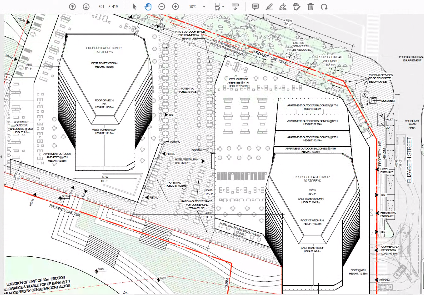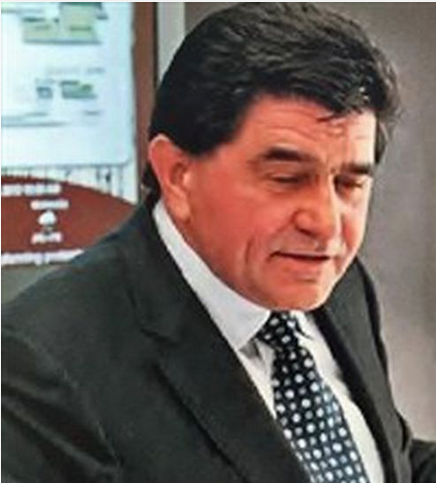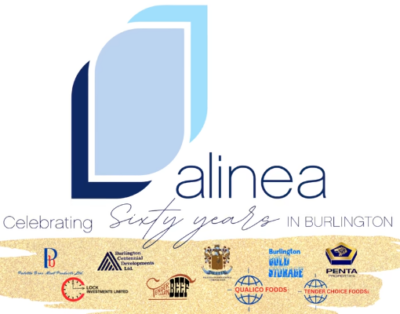April 29th, 2024
BURLINGTON, ON
The Ontario Land Tribunal has started the 2020 Lakeshore Road development appeal to a city decision to to approve the redevelopment of the Waterfront Hotel.
Many thought the city had put that development proposal behind them when the then Minister of Municipal Affairs agreed that the Urban Growth boundary be moved north which took the re-development of the hotel off the table because it was no longer within the Urban Growth boundary.
Darko Vranich, head of the corporation that owns the property has decided he will put his case to the Tribunal nevertheless.
Chris Barnett, a lawyer representing the city summed up what the hearing is about when he spoke at length about the Urban Growth Centre – what the boundaries are now and why they were changed.
“There was an indication that it was a major transit station area. And that meant that the greatest height and the greatest density was directed by policy to the downtown area as being an urban growth center and the city
“Over the course of a number of years the city undertook detailed studies for the downtown area to examine where and how the greatest height and density ought to be directed. And the conclusion of that work was that the urban growth center and the major transit station area identification should not be in the downtown, but rather should be further north around the Burlington GO Station. And that’s ultimately the decision that the city made about where its greatest height and density should be focused.
“But of course, that wasn’t the city’s final decision to make. The city doesn’t have the ability to make those determinations.
“Both the Region of Halton as the upper tier municipality, which at the time and for some weeks to come will continue to have the ability to make decisions on amendments to the city of Burlington official plan as well as the Minister of Municipal Affairs and Housing, which was the approval authority for the Official Plan Amendment, which moved the urban growth center and approved amendments to the regional Official Plan in what’s known as ROPA 48. The Urban Growth Centre boundaries are now in the Burlington GO station in and around that area and no longer in downtown Burlington.
“The application that is appealing a decision which proposed the tallest towers in the city today is on a property that is no longer in an urban growth center or a major transit station area.
“All of the existing towers in the downtown area were approved in the context of a policy that had the urban growth center located in the downtown and that is no longer the case.
 “From an urban structure perspective, the policy context for this site at the regional level in that this area is now no longer part of an urban growth center, but it’s called a secondary regional node. The minimum density targets that were associated with being in an urban growth center and a major transit stationary do not apply to secondary regional nodes, which in the overall hierarchy of growth structure in the region is second from the bottom in terms of the hierarchy of growth.
“From an urban structure perspective, the policy context for this site at the regional level in that this area is now no longer part of an urban growth center, but it’s called a secondary regional node. The minimum density targets that were associated with being in an urban growth center and a major transit stationary do not apply to secondary regional nodes, which in the overall hierarchy of growth structure in the region is second from the bottom in terms of the hierarchy of growth.
“You’ll hear about that policy context, in the opinion evidence of Adrian Smith, who is a land use planner retained by the city to examine the application after the appeals were filed and to provide his independent analysis and opinion which he will share with the tribunal.
 “His conclusion is that the Appeals and the proposal have excessive scale, height and intensity. And it will have inappropriate impacts, including quite crucially, a lack of integration with the surrounding lakefront and park; he’ll give you the full context and reasons for his opinion when he testifies.
“His conclusion is that the Appeals and the proposal have excessive scale, height and intensity. And it will have inappropriate impacts, including quite crucially, a lack of integration with the surrounding lakefront and park; he’ll give you the full context and reasons for his opinion when he testifies.
“You’ll also hear from Katherine Jay, who is also an independent urban designer who was retained to evaluate the applications and provide her opinion after the appeals were filed on both the urban design and landscape architecture aspects of the proposal. And she will provide her conclusions and opinion that the proposed built form is of a scale and mass that has unacceptable impacts on the park and on the lakefront, as well as other urban design and landscape architecture impacts.
“At the end of the day, this the city is not opposed to and in fact supports intensification on this site, but not at the height, the intensity and the scale that’s proposed in the applications that are before you.

There have been some changes to the design. The bridge at the 5th storey level between th two proposed towers is gone and the structure on the east side has been moved closer to the lake. But the height is still there.
“That changed policy context for downtown Burlington has to have meaning. The studies that were undertaken and the approvals by the region and by the Minister, which shifted location of the focus of growth in Burlington has to have meaning. And what that meaning is will be our submission – that downtown Burlington is no longer the location for the highest degree of intensification. And what’s being proposed with these proposed tallest towers in the city is and will result in unacceptable impacts on Spencer Smith Park and on the downtown area.
“The city will respectfully request that the appeals for the Official Plan and Zoning Bylaw Amendment be dismissed by the tribunal.”
That’s what the 15 day plus hearing is about. Chris Barnett nailed it in his remarks this first day of the hearing. Once he had finished everyone else did their best to get as far away from what Barnet put in the table.
The 2020 Lakeshore Road Corporation lost this case back in 2022 when they failed to get necessary documents to city hall in time.
Why Darko Vranich is spending a tonne of money trying to fight what we think is a losing battle is hard to understand.





















“At the end of the day, this the city is not opposed to and in fact supports intensification on this site, but not at the height, the intensity and the scale that’s proposed in the applications that are before you”
You can’t suck and blow at the same time, if the city is in favour of intensification, what is it about this site that they oppose?
“And what’s being proposed with these proposed tallest towers in the city is and will result in unacceptable impacts on Spencer Smith Park and on the downtown area.”
This building isn’t in Spencer Smith Park, it is ajacent so this argument is null and void. It impacts the park no more than the Baxter, or the building beside the Hotel or across the street. Our mayor whom the posters on this website so dearly support (sarcasm) swears she is in favour of building housing and yet how many downtown projects have gone to the OLT during her term as mayor? People need to pick a lane, do we support housing or don’t we?
Editor’s note: It is only now becoming public but some of the two tower project is indeed in public space. Not so null and void after all.
Intensification is not defined as a constant, but has several levels that are based on the City OP and Zoning. This is not permitting anything developers want. This site was okay for some intensification, but not anything goes.
What you are seeing is the attempt by the City to negotiate a resolution of the difference between the two. They are trying to answer your question about what it is about this site that they oppose?
Unfortunately, your choice of language shows clearly that you are not listening – you have made up your mind. This is your own form of suck and blow, and double down with the absurd conclusion that the previous OLT conclusion of refusal of the UCG for Vranko is null and void. The build proposed is pretty much always referred to as part of and in Spencer Smith, and blends right in when built.
Your own form of suck and blow extreme error reflects your failure to pay attention to the way the system actually works, and more broadly what the facts are, not just your rudeness in dismissing the OLT Hearing.
This site was refused first by the Province, as a site for the Vranic proposal intensification level of UGC – 30 to 35 stories). After that, it was refused by OLT because Vranic didn’t accept the decision by the Province, and and then the City support of the Province, and so appealed the City subsequent decision to refuse the proposal by Vranic that did not accept the province decision either.
It looks too like Bob doesn’t know the history of this project either. Vranic’ chief tactic in this development proposal is to appeal to OLT everything that they have the right to.
So this Hearing is the 5th appeal they are involved in over this matter, and they have basically refused to obey the Planning Laws of the Province and the OLT.
They have publicly demonstrated the unwillingness to budge from the UGC OP and Planning heights and built form towards the City and preferred version.
Edited
Since you know so much more than I, please define what level of intensification would suffice and WHY that level. If 20 stories is OK does that not block the view of the lake any more than 23, 28 or 280?
The Bridewater development was encouraged by the city of Burlington and so it was in fact the city that set the standard that blocking the view of the lake is OK. The stipulation being that there needed to be a view of the lake through Elizabeth St which this application stays true to. (see I do pay attention)
If their appeals were groundless it would have been squashed before the hearing, there are enough grounds in their 5th appeal for the OLT to hear this. Part of negotiations is bargaining in good faith and when Vranko bought this land it was part of the area marked for intensification. It wasn’t Vranko that changed the rules mid game which is why they keep appealing, it is the city, region and province changing the rules.
If I don’t know the history of this project then please explain what downtown developement you HAVE supported??? Just one, because I’ve been reading this news source for a long time and certain people have nothing to say about anything that is happening to our downtown that isn’t anti development. We are in the middle of a housing crisis, we can build high rises and put roofs over peoples heads or your beloved park will end up with housing anyway only it’ll be made of canvas and they will be rent free.
You have posted a lot of conclusions about what I do and don’t understand. What I have done is quoted the city lawyers own arguments. I never doubled down on anything, as it is you putting words that didn’t exist and trying to say I said them. I didn’t; I quoted the article. I asked what the CITY considers intensification because that is what the CITY representative at the OLT said. I never mentioned the previous OLT hearing at all so where do you figure I’m doubling down on an argument never made? The facts you so elequently think I’m missing are right there in my post with quotes on them.
Editor’s note:
Couple of comments. At one point what we know as the Bridgewater development was going to be 30 storeys high. The entrance to the view of the Lake if not off Elizabeth street – it is off Lakeshore Road. We were originally very concerned about what kind of an entrance there would be. It turns out to be very good – walk out some time and enjoy the public access.
The Bridgewater and whatever the Waterfront site gets called is not going to be anywhere near affordable. The bulk of the early purchases might follow the usual pattern – investors by them up and resell when they are completed.
These places are not going to be something most of us will be calling home.
The point we think is being missed is the ROPA 48 document. The site is not within the Urban Boundary – can’t be built in that location. That’s a fact.
The short and early presentations cut through the gross redundancy in the several presentations to the quick. This joint document actually has 7000 pdf pages.
The province and OLT took away the UGC from Vranko and the more permissive zoning that went with it. This action makes it obvious that the Province and OLT have refused to approve what Vranko submitted in the strongest terms.
The modified submission does not fit the the designated OP and Zoning. Vranko is, to repeat; OUTSIDE THE UGC. A difficulty of interpretation is what exactly does this mean? What exactly does this mean in terms of real built form? How do you know, or even can know, when you get there, – outside – from the Vranko submission?
Mr. Vranich is really spending a large amount of money, with which, even just today, produced so many details that to me, it will be impossible to synthesize it to a meaningful interpreted form that will convince me it is the preferred outcome project that is better than what the City envisions is what they want.
What I really see happening in front of me is an effort to negotiate a settlement. There are certainly all the expertise and competency needed (there were 20 people in the virtual world today). They are spending all the money you could want I think: studying and presenting; or having studied everything when this is done.
This is basically okay with me given the realty. I just don’t want it to go back to the OLT and the poor sole responsible Chair, who is supposed to do her best to manage and sustain the pace of comprehension, that is difficult daily, never mind for a 15 day Hearing.
As far as I am concerned, besides money, it is nothing new, except this is the absolute prime location for the LEGACY. This really must be something top-drawer, for the City from the City.
The City lawyer fellow, Chris Barnett, cited by Pepper, said it for the City, from the heart I think. The OLT, at appeal, already refused the policy end of this for the province, in the strongest terms.
“That changed policy context for downtown Burlington has to have meaning”.- are the OLT supposed to completely reverse themselves?
” The proposal on the table does not fit Burlington where it is proposed. It is no longer the location for the highest degree of intensification. What’s being proposed with these proposed tallest towers in the city is and will result in unacceptable impacts on Spencer Smith Park and on the downtown area.”
If we are to have an OLT reversal , bought by pots of money, then OLT has no meaning.
To me, it was the final, initial words of David Bronskill, lawyer for 2020 Lakeshore applicant Vranko, that struck me.
One of the last things he said was that in the end of his early morning overview talk – he said, at bottom, the discussion and debate here, boils down to really about “height” – that was actually the word he used. He also said, we could hardly avoid doing something about the height, given the “housing crisis” we are in.
Without a new start without UGC permissions, it looks to me like Vranko will want to take what is essentially based on the UGC model and try to negotiate – they clearly show that intention in their actions.
They will argue Provincial Growth Plan policies, which is their perspective and job. It’s a slippery slope between this Growth Plan, and where does the legally forbidden UGC stand for this Hearing.
Is this statement by BronskillI a step on the step to the Growth Plan, and using it to argue the Growth Plan and a so-called housing crisis? don’t recall him saying “affordable”, but I was struck that he would venture a policy opinion that the 2020 Lakeshore Rd proposal could even be associated in the same thought with delivering remedies for a housing crisis, or anything anywhere near “affordable”.
The2020 Lakeshore proposal can be confidently stated as never doing anything about meaningful housing, and “affordable” is just a dumb thought that should not even entertain a meeting such as this.
This is not credible – it is just silly nonsense waste of time to me to think this is even plausible.
Just do the math – pencil it out.
Why would the OLT even look at this? Spending valuable time and taxpayers dollars on a case that was already decided municipally! When is reason going to prevail and decision-making allowed to rest where it belongs- locally, not provincially?